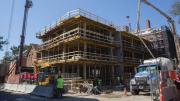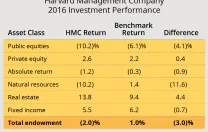An article on “House Renewal Gains and Challenges” in the September-October issue reviewed the successes of the College’s renovation of undergraduate residences to date, the schedule for the next renewal projects, and the status of fundraising for the program, which has been estimated to cost $1.4 billion. It also noted inflating Boston-area construction costs, rising 5 percent to 7 percent annually—and raised, but could not fully answer, questions about how the full program could be paid for in a timely way.
Additional information made available after that article went to press was published online (see “House Renewal Update,” available at here). These are highlights:
- Decapitalizations. During fiscal years 2011 through 2015, the Faculty of Arts and Sciences (FAS) drew upon $358 million of appreciated endowment funds for House renewal: $253 million to pay for project costs; and $105 million to pay down existing debt (most of it incurred to build science facilities in the prior decade)—in effect creating room for future House-renewal-related borrowing.
- Income effect. Subject to several assumptions and variables, those decapitalizations are calculated to reduce FAS’s flow of cash, distributed from the endowment and applicable to its most pressing needs, by about $25 million through the renewal project’s projected conclusion in fiscal 2025. The loss of income of course continues thereafter, given the permanent withdrawal of capital from the endowment and forgone appreciation and distributions. (See “The Endowment Ebbs,” page 18, for discussion of the faculty’s reliance on endowment distributions, and the challenges of weak investment performance.)
- Spending. Through May 31, FAS had spent $391 million on planning and architectural costs; completed reconstruction of Stone Hall, Leverett McKinlock, and Dunster House; preliminary work on Winthrop House, where full construction began just after Commencement; and design and preliminary work on Lowell House, scheduled to ramp up next summer. The funds came from FAS’s decapitalizations, its reserves, and campaign gifts and pledge payments. The pace and scale of spending are now rising rapidly, for the Winthrop and Lowell projects.
Remaining project financing depends on continued robust fundraising, and on some form of borrowing. The details will require the Corporation to determine how much FAS can borrow and on what terms; what part of the program, if any, might be deemed a University priority (as is the case for the new Allston facilities for FAS’s engineering and applied sciences faculty), among other competing aims; and how long Harvard can wait, in light of escalating construction and materials prices, to bring the remaining River Houses up to twenty-first-century standards.










